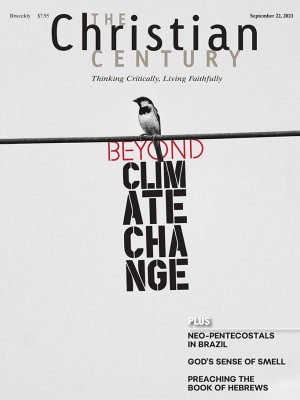October 3, Ordinary 27B (Hebrews 1:1-4, 2:5-12)
Israel’s claim that all people are created in God’s image is strikingly egalitarian.
Read the author’s article on preaching Hebrews without supersessionism.
Christians can meditate on these two passages from Hebrews throughout their lives without ever exhausting them. One fascinating aspect is the relationship between Christology and anthropology: what we confess about Jesus Christ and what we profess about people.
Christ is “the reflection of God’s glory and the exact imprint of God’s very being,” writes the author. Ideas about images of God are both biblically central and historically influential. They can be likened to a frame with four corners: no images of God are possible, many images of God are needed, every person is an image of God, and Christ is the image of God.
Read our latest issue or browse back issues.
No images of God are possible. A basic idea in the Jewish-Christian tradition—and later, even more so in the Muslim tradition—is that God cannot be captured by our thoughts, texts, music, or images. An image of God therefore easily becomes an idol; the most famous example is the golden calf in Exodus 32. The people ask Aaron for a concretization: “Make us a god who can go before us.” Aaron agrees and has a bull calf cast: “This, O Israel, is your God, who brought you out of Egypt,” in an obvious allusion to the Decalogue. But like images, our way of focusing on certain words and formulations can in the long run be treacherous.
Language is power. Everyone who has had to argue their case in a foreign language knows this, whether it is about a restaurant bill or a doctoral dissertation. The reason is that what we can name we can also to some extent master. (We usually say that we master a language if we speak it fluently.)
Because of this connection between naming and claiming mastery, Jews avoid pronouncing the tetragrammaton (the four consonants of the name of God: Y, H, W and H). Instead, various paraphrases are used (the Lord, the Name, the Place). Jesus adhered to this paraphrasing tradition. For example, the prodigal son says, “Father, I have sinned against heaven and against you” (Luke 15:21).
For Christians, the paraphrasing tradition is a useful reminder that we cannot comprehend God; we can only approach the Divine with insufficient words and images.
Many images of God are needed. Nuances abound in languages. Anyone who has done translation knows this. We must constantly explain, add, and interpret. The more abstract the subject, the more difficult it becomes to find the right words. Therefore we use various metaphors and concepts—and we have to be aware of their limitations. There are several names for God and ways of talking about God. No single one can tell us everything.
Every person is created in the image of God. In her article in Christianity in Jewish Terms, an impressive collection of essays, Tikva Frymer-Kensky argues that it is unremarkable for the Bible to claim that a human being could be an image of God. Regents and religious leaders in other ancient cultures were often considered to be such images, for example, Tutankhamun means “Amon’s living image.” The remarkable thing about Israel’s interpretation was that all people were considered to be created “in image” (be-tselem) of God. This view is strikingly egalitarian.
But what does it mean that every person is created be-tselem? One answer suggests that it means that human beings are religious beings. Another emphasizes that we are not only images of God but also called to become even more so in word and deed: the term is not only indicative but also imperative. The word tselem is similar to tsel, which means “shadow.” Rabbi Abarbanel (1437–1508) therefore argued that the one who is created be-tselem should follow God like a shadow. There is an inextricable link between the concepts imago Dei (“image of God”) and imitatio Dei (“likeness of God”).
A third line of thought argues that the God who cannot be depicted is nevertheless reflected in fellow human beings. This idea has perhaps been most clearly developed by Rabbi Yehoshua ben Levi (early 200s CE). The starting point for his Midrash is Psalm 55:19, which says ki ve-rabbim hayu ‘immadi (approximately, “because of the many who were with me”). He suggested that this means that in front of every person walk the angels of God, and in front of the angels walks a herald who solemnly announces: tenu maqom le-iqonin shel ha-Qadosh barukh hu (“Make way for the image of the Holy, Blessed One”). It is interesting that the rabbi uses a Greek loanword: behind the Hebrew iqonin we find eiko-n and eikonion (see also the English word icon). The implication is that every human being should be regarded as a wandering icon. The one who cherishes and reveres this icon sees something of who God is.
Christ is the image of God. In the first paragraphs of both John’s Gospel and 1 John it is emphasized that Christ is the Word of God incarnated. Colossians 1:15 states that he is the eikōn of the invisible God. And the two words used in Hebrews are apaugasma (“radiance”) and charaktēr. The latter word (and the related charagma) originally referred to the minting of a coin attesting to its value. The idea is that Jesus of Nazareth is God’s visible imprint in this world, the one who certifies how God values people.
This is why Christology cannot be separated from anthropology. My Christology is high anthropology.





